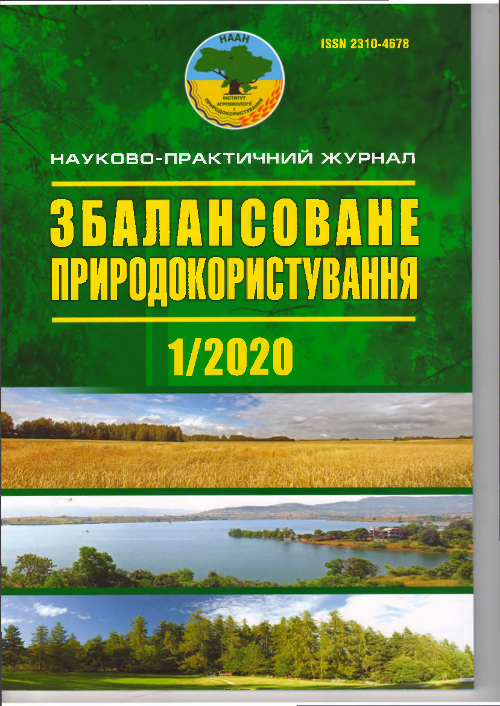Вплив сількогосподарської діяльності на баланс поживних речовин у ґрунтах Житомирської області
DOI:
https://doi.org/10.33730/2310-4678.1.2020.203942Ключові слова:
баланс, гумус, поживні речовини, культура, грунт, сільськогосподарське підприємство, районАнотація
Відомо, що в Україні сільське господарство розвинуте значно більше, ніж промисловість. Це зумовлено наявністю на території нашої держави високопродуктивних земель, зокрема чорноземів, які є національним багатством та захищені конституцією України. Саме це і зумовлює належність України до аграрних держав світу. Як наслідок, рівень розорюваності земель нашої країни є доволі високим, а посівні площі займають значну частку сільськогосподарських угідь. З іншої сторони, інтенсивне залучення земель до виробництва аграрної продукції призводить до погіршення стану грунтів, зниження їх природної родючості. Відсутність жорсткого контролю з боку держави за використанням угідь товаровиробниками лише підсилює наслідки антропогенного впливу на якість ґрунту. Житомирська область територіально знаходиться в зоні Полісся та Лісостепу. Переважаючим типом ґрунтів на її території є дерново-підзолисті (понад 60%) із вмістом гумусу до 1,5%. Такі грунти характерні для північних районів області. Лісостепова частина Житомирщини вирізняється більш родючими ґрунтами із вмістом гумусу понад 2,5%. Посівні площі Житомирської області становлять 648,1 тис. га. Сільськогосподарські підприємства мають переважно зерновий напрям, оскільки у структурі посівних площ основну частку займають зернові та зернобобові, кукурудза на зерно, а також соняшник, соя і ріпак. До районів із найбільшою часткою орних земель належать Андрушівський, Бердичівський, Ружинський, Попільнянський, Чуднівський, Черняхівський та Брусилівський із площею орних земель 38,2–53,6% загальної території району. У системі землеробства аграрії області недостатньо використовують мінеральні та органічні добрива. Про це свідчить від’ємний баланс поживних речовин, який становить 35,5 т усієї посівної площі. Щодо мінерального удобрення, то воно використовується товаровиробниками більш інтенсивно, ніж органічне при вирощуванні сільськогосподарських культур. Удобрені площі в розрізі районів Житомирщини показані на відповідних картосхемах. За нашими дослідженнями найвищим середньозваженим показником гумусу у ґрунті характеризуються Чуднівський (2,54%), Андрушівський (2,62%), Житомирський (2,63%) та Ружинський (2,9%) райони. Саме на цій території використання земель з екологічної точки зору можна назвати таким, що не суперечить чинному законодавству України. В цілому по області під культурами сформувалось 838888 т гумусу на площі 607,1 тис. га. Проте основна частка у процесі гуміфікації належить саме рослинним решткам, а не органічним добривам. Отже, низький рівень використання добрив сільськогосподарськими підприємствами зумовлює дефіцит поживних речовин у ґрунті посівних площ та свідчить про нераціональне використання земель у сільськогосподарському виробництві.
Посилання
Land Code of Ukraine. URL: https://zakon.rada.gov.ua/laws/show/2768-14
Balyuk, S.A., Medvedev, V.V. (2012). Stratehiya zbalansovanoho vykorystannya, vidtvorennya i upravlinnya gruntovymy resursamy Ukrayiny [Strategy of balanced use, reproduction and management of soil resources of Ukraine]. K.: Agrarna nauka: 240. [in Ukr.].
Tretyak, A.M. (2008). Zemlevporyadne proektuvannya: teoretuchni osnovu ta terytorialnyi zemleustriy [Land design: theoretical foundations and territorial land management]. Kyiv: CZRU: 576. [in Ukr.].
Balyuk, S.A., Nosko, B.S., Skrylnik, E.V. (2016). Current problems of biological degradation of black earths and ways of preserving their fertility. Bulletin of agrarian science. 2016: 11–17 [in Ukr.].
Skrylnik, E.V. (2010). Transformation of humus soil condition and their energy intensity under the influence of different fertilizer systems. Visn. center of sciences. provision of APV. 2010: 7. 184–194 [in Ukr.].
On State Control over the Use and Protection of Land: the Law of Ukraine of 16.09.2008. URL: https://zakon.rada.gov.ua/laws/show/963-15.
On Land Management: the Law of Ukraine of 05.11.2009. URL: https://zakon.rada.gov.ua/laws/show/858-15.
Vishnevskyi, F.A. et al. (2018). Dynamics of humus content in soil cover of arable lands of Andrushevsky district of Zhytomyr region. Agroecological journal. 2. 44–49 [in Ukr.].
Major, J., Lehmann, J., Rondon, M., Goodale, C. (2010). Fate of soil-applied black carbon: downward migration, leaching and soil respiration. Glob. Chan. Boil. 1. 1366–1379. [In Engl.].
Murage, E., Voroney, P. (2008). Distribution of organic carbon in the stable soil humic fractions as affected by tillage management. Canad. J. Soil Sci. 88, 1. 99–106 [In Engl.].
Polupan, M.I., Solovey, V.B., Kisil, V.I., Velichko, V.A. (2005). Vyznachnyk ekoloho-henetychnoho statusu ta rodyuchosti gruntiv Ukrayiny: navch. posib. [Determinant of ecological-genetic status and soil fertility of Ukraine: textbook. tool]. 304. [In Ukr.].
Gnatenko, O.F., Kapshyk, M.V., Petrenko, L.R., Vitvitsky, S.V. (2005). Gruntoznavstvo z osnovamy heolohiyi [Soil science with the basics of geology]. Kyiv: Oranta: 648 [In Ukr.].
DSTU 4289: 2004. Soil quality. Methods for determining organic matter [Valid from 2004-8-18]. K.: State Consumer Standard of Ukraine, 2005: 9. (Information and documentation).
##submission.downloads##
Опубліковано
Номер
Розділ
Ліцензія
- Автори залишають за собою право на авторство своєї роботи та передають журналу право першої публікації цієї роботи на умовах ліцензії Creative Commons Attribution License, котра дозволяє іншим особам вільно розповсюджувати опубліковану роботу з обов'язковим посиланням на авторів оригінальної роботи та першу публікацію роботи у цьому журналі.
- Автори мають право укладати самостійні додаткові угоди щодо неексклюзивного розповсюдження роботи у тому вигляді, в якому вона була опублікована цим журналом (наприклад, розміщувати роботу в електронному сховищі установи або публікувати у складі монографії), за умови збереження посилання на першу публікацію роботи у цьому журналі.
- Політика журналу дозволяє і заохочує розміщення авторами в мережі Інтернет (наприклад, у сховищах установ або на особистих веб-сайтах) рукопису роботи, як до подання цього рукопису до редакції, так і під час його редакційного опрацювання, оскільки це сприяє виникненню продуктивної наукової дискусії та позитивно позначається на оперативності та динаміці цитування опублікованої роботи (див. The Effect of Open Access).


